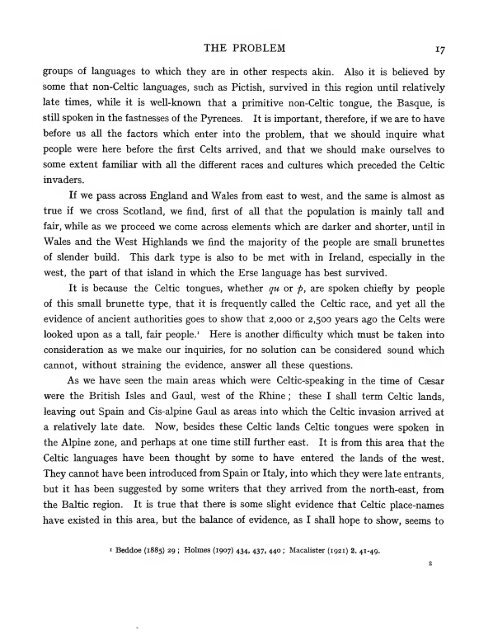The bronze age and the Celtic world - Universal History Library
The bronze age and the Celtic world - Universal History Library
The bronze age and the Celtic world - Universal History Library
You also want an ePaper? Increase the reach of your titles
YUMPU automatically turns print PDFs into web optimized ePapers that Google loves.
THE PROBLEM 17<br />
groups of langu<strong>age</strong>s to which <strong>the</strong>y are in o<strong>the</strong>r respects akin. Also it is believed by<br />
some that non-<strong>Celtic</strong> langu<strong>age</strong>s, such as Pictish, survived in this region until relatively<br />
late times, while it is well-known that a primitive non-<strong>Celtic</strong> tongue, <strong>the</strong> Basque, is<br />
still spoken in <strong>the</strong> fastnesses of <strong>the</strong> Pyrenees. It is important, <strong>the</strong>refore, if we are to have<br />
before us all <strong>the</strong> factors which enter into <strong>the</strong> problem, that we should inquire what<br />
people were here before <strong>the</strong> first Celts arrived, <strong>and</strong> that we should make ourselves to<br />
some extent famihar with all <strong>the</strong> different races <strong>and</strong> cultures which preceded <strong>the</strong> <strong>Celtic</strong><br />
invaders.<br />
If we pass across Engl<strong>and</strong> <strong>and</strong> Wales from east to west, <strong>and</strong> <strong>the</strong> same is almost as<br />
true if we cross Scotl<strong>and</strong>, we find, first of all that <strong>the</strong> population is mainly tall <strong>and</strong><br />
fair, while as we proceed we come across elements which are darker <strong>and</strong> shorter, until in<br />
Wales <strong>and</strong> <strong>the</strong> West Highl<strong>and</strong>s we find <strong>the</strong> majority of <strong>the</strong> people are small brunettes<br />
of slender build. This dark type is also to be met with in Irel<strong>and</strong>, especially in <strong>the</strong><br />
west, <strong>the</strong> part of that isl<strong>and</strong> in which <strong>the</strong> Erse langu<strong>age</strong> has best survived.<br />
It is because <strong>the</strong> <strong>Celtic</strong> tongues, whe<strong>the</strong>r qu or p, are spoken chiefly by people<br />
of this small brunette type, that it is frequently called <strong>the</strong> <strong>Celtic</strong> race, <strong>and</strong> yet all <strong>the</strong><br />
evidence of ancient authorities goes to show that 2,000 or 2,500 years ago <strong>the</strong> Celts were<br />
looked upon as a tall, fair people.' Here is ano<strong>the</strong>r difficulty which must be taken into<br />
consideration as we make our inquiries, for no solution can be considered sound which<br />
cannot, without straining <strong>the</strong> evidence, answer all <strong>the</strong>se questions.<br />
As we have seen <strong>the</strong> main areas which were <strong>Celtic</strong>-speaking in <strong>the</strong> time of Caesar<br />
were <strong>the</strong> British Isles <strong>and</strong> Gaul, west of <strong>the</strong> Rhine ; <strong>the</strong>se I shall term <strong>Celtic</strong> l<strong>and</strong>s,<br />
leaving out Spain <strong>and</strong> Cis-alpine Gaul as areas into which <strong>the</strong> <strong>Celtic</strong> invasion arrived at<br />
a relatively late date. Now, besides <strong>the</strong>se <strong>Celtic</strong> l<strong>and</strong>s <strong>Celtic</strong> tongues were spoken in<br />
<strong>the</strong> Alpine zone, <strong>and</strong> perhaps at one time stiU fur<strong>the</strong>r east. It is from this area that <strong>the</strong><br />
<strong>Celtic</strong> langu<strong>age</strong>s have been thought by some to have entered <strong>the</strong> l<strong>and</strong>s of <strong>the</strong> west.<br />
<strong>The</strong>y cannot have been introduced from Spain or Italy, into which <strong>the</strong>y were late entrants,<br />
but it has been suggested by some writers that <strong>the</strong>y arrived from <strong>the</strong> north-east, from<br />
<strong>the</strong> Baltic region. It is true that <strong>the</strong>re is some slight evidence that <strong>Celtic</strong> place-names<br />
have existed in this area, but <strong>the</strong> balance of evidence, as I shall hope to show, seems to<br />
I Beddoe (1885) 29 ; Holmes (1907) 434, 437, 440 ; Macalister (1921) 2. 41-49.







